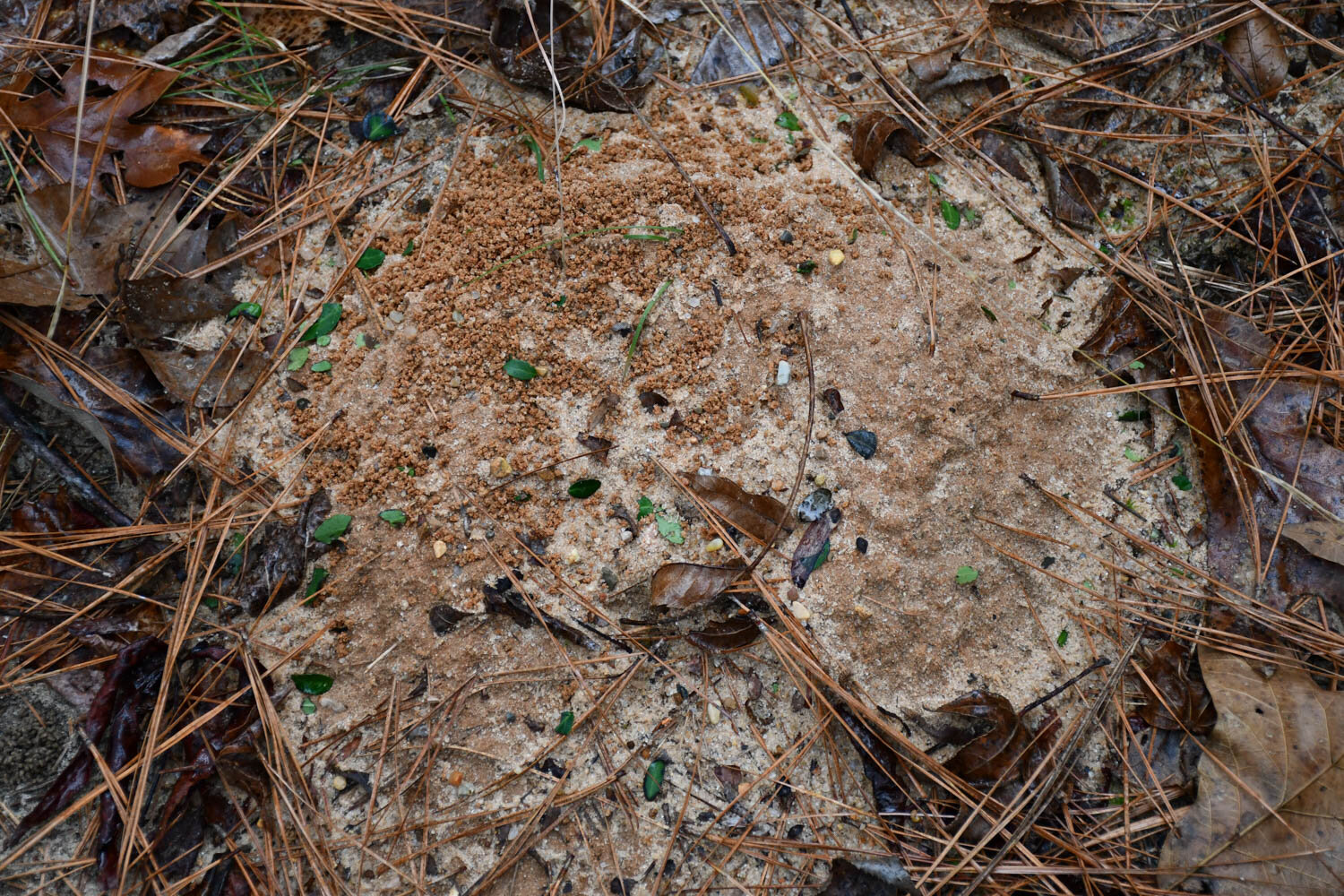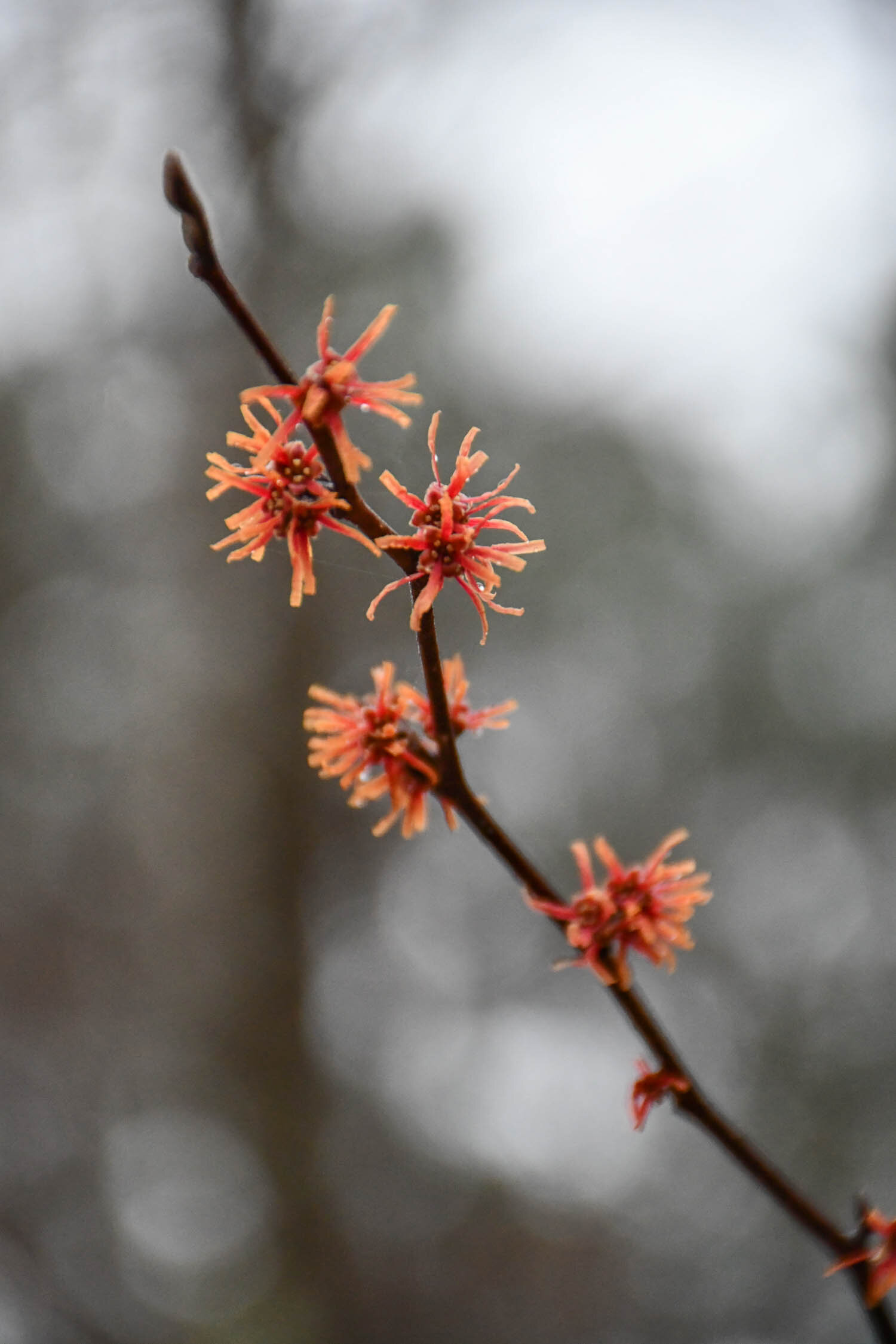I joined Peter Loos and Dawn Stover on a recent botanizing trip in early January to look at some of some rare native flora in east Texas. Tagging along with us were Jordan Cunningham, Dawn’s greenhouse assistant, and Cole Gandy, a horticulture graduate student.
SEEDS OF A BOTTLE
Our first target for the day was Gentiana saponaria, the soapwort gentian. While plentiful back east, it is very rare in Texas. Naturalist Matt Buckingham stated that there may only be five populations in Texas.
Gentiana saponaria habitat in east Texas.
While the plants bloomed back in November and December, our quest today was to ascertain the seed set on them. We arrived at our site far down a logging road under gray skies on a warmish winter day. Dawn and Peter had flagged plants back when they were in bloom, and now we could check pollination success.
While many flowers had no seed, some did. Gentiana saponaria is a bottle gentian, named because the tops are closed and require a pollinator like a bumblebee to force them open. Dawn found a capsule split above a flower and pointed out to me how interesting the seed dispersal was. We looked at some seeds closer up. They were as fine as dust and resembled teardrops. At the time, I thought it odd as to how the capsule got above the spent flower. Once I got home I would discover that once pollinated the pedicle of the flower actually elongates so that the seed can find a new home. We checked approximately 25 plants, but I’d say we only observed seed on about 7 of them.
A hint of color left on this Gentiana saponaria
Once pollinated, the pedicel elongates to disperse the next generation. If you look closely at the base of the V, you can see the dusty, white seed.
Here’s a close up of a damaged seed pod. Notice how fine the seed are.
Peter Loos checks a Gentiana saponaria for seeds. Many grew on the sides of the creek.
Most of the plants that we looked at were either clinging to the edge of the stream or within 20 feet of it. The stream likely acts as a refugium for this species, providing water and perhaps a fire break to prevent reproductive damage. Peter commented to Cole that later in life he should come back and see if the gentians are still here. We certainly hope so, but this species is likely a relic from when Texas was much cooler and wetter. If the climate continues its warming and drying trend, gentians may one day be absent from Texas. That is why these investigations into the reproductive success of Gentiana saponaria are important. Dawn and Peter’s work is trying to prevent their demise and preserve the genetics of this southwestern population.
WITCHHAZEL HUNT
The second species, and one that I have wanted to see for some time, was Hamamelis ovalis, the big-leaf witchhazel. I’m a witchhazel nut, and I wish so much that we could grow many of the hybrids in Texas. But, alas they struggle in the deep south due to our lack of chilling hours.
The other reason I was excited to see this species is because it is fairly new to science. In 2004, Steve Leonard found what would become Hamamelis ovalis in Mississippi. He noted even though it had similar red-to-yellow flowers and bloom time to Hamamelis vernalis that occurs in the Ozarks, it was about 600 miles further south. And, while this witchhazel distribution overlapped with Hamamelis virginiana in the Mississippi locale, this species had larger leaves and tomentose (aka fuzzy) undersides to the leaf. He published the name and description along with a great write up in Sida, Contributions to Botany in 2006. Then, in 2009 Wayne Webb found a population of these plants in Alabama, and since then it has been found in a total of five counties in Alabama.
Peter said that he had been shown this Hamamelis by Lynn Lowery in mid-1980 when these populations in east Texas were classified as disjunct occurrence of Hamamelis vernalis. Later, Peter found additional sites like the ones we saw last May on our class outing, and it was sometime around 2010 after Hamamelis ovalis was named that he began to suspect that what occurred in Texas was actually Hamamelis ovalis all along. He and other native plant experts in the area have come to the same conclusion.
Even though it may only occur in a handful of places in the southeast, this southern species deserves wider use. Hardiness further north doesn’t seem to be much of an issue. There are specimens in the Arnold Arboretum in Massachusetts (zone 6b).
Hamamelis ovalis begins flowering in the wilds of east Texas. Their strap-like (aka ligulate) petals unfurling reminds me of octopus tentacles.
We parked on a logging road, and clambered up the hillside of the right-of-way to find a dense thicket of trees. Right inside was a wide10-foot-tall Hamamelis ovalis just starting to put on a show. The flowers were smaller, just like the rest of its native cousins. However, they were colorful, and many individuals reminded me of the coloration you see on ‘Jelena’ or ‘Wisley Surpreme’. Peter commented that we were early. Last year when he visited, he could see the large tree through the brush from the other side of the road.
I had read online another identifying feature is to tug on the new shoots around the base. On Hamamelis ovalis, they will give some, and sure enough branches did rise up from the ground with a gentle heave. My hands moved from a larger branch to a smaller pencil-thin whip and I noticed an abundance of pubescence. As far as fragrance, it varied specimen to specimen. Some you would catch that sweet witchhazel smell while others had little if any scent.
As we explored the population, Peter pointed out a large colony of Texas leaf cutter ants and commented that they had been there as long as he has been visiting this site. The space the mounds occupied could have easily fit into two or three parking spots. He joked, “This time of year, yaupon holly is about all you’ll see around the holes. They’re caffeine addicts!”
A Texas leaf cutter ant mound. Notice the abandoned shreds of Ilex vomitoria.
A minute or two later as I was photographing a witchhazel I noticed one of the ligulate petals moving. A leaf cutter ant was hauling it away!!! I gave a little squeal at seeing this little marvel of nature. Seems we humans are not the only creatures that enjoys the blooms.
A Texas leaf cutter ant carries a witchhazel petal.
Having seen the diversity at this site, we got back in our cars, and drove down the road a bit to a second Hamamelis ovalis site at a local trail. We walked about half a mile to a see a second population, passing emerging Trillium and a forest that more closely resembled the east coast than Texas.
Early Trillium foliage rises from the leaf litter.
We reached a spot in the trail where more light came through the bare canopy. At first, all we could find was small Hamamelis saplings, but before we left I was spotting small trees 12-to-15 feet tall with their blooms high above. Peter said that many of the runts were likely small due to dense shade from the canopy, but a storm a few years ago removed some branches and opened it up for more light to reach the forest floor.
One of the taller big-leaf witchhazels. You can see the blooms against the darker colored tree trunks.
While we noticed more interesting color variants (even a yellow flowering one!), it was here that I really started to see some clonal nature to this species. Two specimens a few feet apart would have the same color pattern, or you could see at another colony where two seemed to grow out from the same spot yet be a few feet apart. Another gentle yank on some showed me the plants had layered on the forest floor.
This clone faded from red to orange to yellow in the petal.
A more orange colored form.
We even found a yellow flowering big-leaf witchhazel!
At this second location, I also saw Hamamelis ovalis exhibiting a common characteristic to witchhazels, marcescent foliage. It varied from clump to clump as far as how many leaves were retained, but in general most of them were deciduous.
We headed back to the cars from a day full of botanizing and learning more about the flora of Texas. Even in the dead of winter there are plants to be enjoyed, and with a better understanding of soapwort gentian and big-leaf witchhazel, I hope these jewels of the winter landscape can be preserved and continue to shine for many years to come.
One final glimpse of big-leaf witchhazel in flower. What rich color for a gray day!















